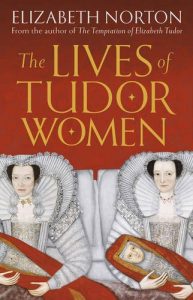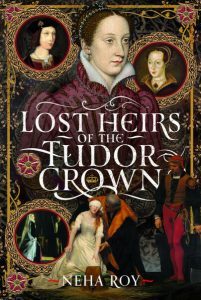Elizabeth Norton is the author of ‘The Lives of Tudor Women’, ‘The Temptation of Elizabeth Tudor’, ‘England’s Queens’, ‘She Wolves: The Notorious Queens of Medieval England’, as well as individual biographies about Anne Boleyn, Jane Seymour, Anne of Cleeves, Catherine Parr, Margaret Beaufort and Bessie Blount.
The paper back of Elizabeth’s latest book, ‘The Lives of Tudor Women’ was published by Head of Zeus last month.
To buy ‘The Lives of Tudor Women:
Follow Elizabeth on Social Media:
Elizabeth’s website: Elizabeth Norton
Twitter: @ENortonHistory
Many thanks to Elizabeth for answering my questions.

(c) Head of Zeus
Why did you choose this subject for your book?
History is so often written about men, with social histories often including a chapter on women before using the remainder of their pages to discuss men as though they were representative of the whole of society. This happens even in the Tudor period, which was of course so politically dominated by women. I was therefore very keen to write this book as a means of redressing the balance. I wanted to look at women’s lives rather than women’s issues. The book therefore focusses on women, looking at all aspects of their lives even when they overlapped with men.
Women made up approximately 50% of the Tudor population and I therefore wanted to provide a picture of what their lives were like. I wanted to move away from the stereotype of powerless or uninteresting/unimportant women. It was a dauntingly large project, but probably the most enjoyable and rewarding piece of historical research that I have ever embarked upon.
What does your book add to existing works featuring Tudor women?
When I first decided to write the book, I was adamant that the stories of lower status women should be included. Works on Tudor women disproportionately focus on upper class women, such as the wives of Henry VIII or his daughters. While their lives are undoubtedly fascinating, they cannot be said to be representative of what life was really like for the majority of the people of England. Other books have been written about Tudor women, but none have delved so deeply into just what life was like for a woman of all classes. It is both social history and biography, providing a comprehensive account of the central Tudor Everywoman figure.
Why did you decide on the ‘Seven Ages of Man’ for the structure?
Devising the structure for such a broad book was a real challenge. However, I was immediately drawn to the idea of writing about a Tudor everywoman figure – a concept that would have been familiar (as an ‘everyman’) to contemporaries. What I like about the concept of the Seven Ages of Man is that they were intended to be a universal idea, applicable to all. Yet, manifestly, this is not the case. Shakespeare’s scheme and the countless others around in the period only dealt with male lives. Stages that include a soldier or a justice of the peace cannot also apply to women. I therefore wanted to devise the Seven Ages of Women, on which all the stories contained in the book are hung.
Which was the most interesting ‘Age’ for you to write about?
The most interesting age was definitely the final age, that of the elderly. Only a small proportion of people in Tudor England made it to advanced age and it was therefore the life stage that I knew the least about. For women, it could be a time of considerable hardship, since there was no retirement. With women then – as now – tending to outlive men, many poor widows eked out a miserable existence spinning or making hose into their eighties and even nineties. Old women were also viewed with suspicion, with the elderly poor particularly vulnerable to witchcraft accusations. Even for wealthy and influential women, like Elizabeth I, old age was a difficult life stage to negotiate. It is no surprise that Elizabeth sought to preserve the myth of her eternal youthfulness for as long as possible.
What surprised you most researching this book?
I was most surprised by the volume of surviving material for lower status women in the period. The number of documents relating to women which exist still untranscribed in archives is astonishing. In St Bartholomew’s Hospital Archives in London, for example, I was able to research the career of the hospital’s matron, Sister Fisher, while in the Draper’s Company in London I could read about the Draper’s widow and businesswoman, Katherine Fenkyll. City and local archives were filled too with accounts of the lives of many ordinary women, including runaway servants and simple housewives. There is a huge body of material available for a study of women in the period, with many of the sources used in the book never printed or discussed before.
Why did you choose to include the separate information panel sections?
While I wanted the book to primarily function as a collective biography, looking at a Tudor Everywoman figure, there were some topics that were just to interesting to be glossed over or ignored. Every chapter includes one or two separate information panel sections which deal with a topic relevant to that chapter. These deal with a wide range of topics, including swaddling bands, pleading the belly, surgery, female centenarians, make up and ducking stools. The aim was to give an even broader picture of life without moving too far away from the main lives discussed in those sections.
Do you have a favourite woman’s story?
Absolutely. While all the stories were fascinating in their own way, my favourite has to be Elizabeth Barton, the famous (or infamous) Nun of Kent. Barton was a peasant girl who worked as a domestic servant in Kent. She fell ill and it was soon reported that she was having heavenly visions. The then Archbishop of Canterbury, William Warham, arranged for Barton to become a nun in Canterbury and he later organised an interview for her with Cardinal Wolsey. It was at that meeting that Barton first made it clear that she did not support Henry VIII’s ‘Great Matter’ and his proposed marriage to Anne Boleyn.
Barton became one of the most vocal and politically important opponents to the marriage, with Thomas More and Bishop John Fisher of Rochester believing her words. Even the pope’s ambassadors met with her on their knees. Thomas Cranmer, who succeeded Warham as Archbishop of Canterbury, for one, believed that both Wolsey and Warham were afraid of Barton and that she greatly set back the king’s marriage. She also told the king of her opposition towards him to his face in several interviews.
Elizabeth Barton’s career finally came to an end in late 1533. She had originally predicted that Henry would not survive marriage to Anne Boleyn by six months and, when the king survived this period, Barton’s credit was fatally damaged. Under interrogation, she confessed that she had feigned her visions and she was eventually hanged in 1534. Barton’s story is so fascinating because it was so unusual. She went from an incredibly lowly background to become one of the most important politicians in England. Interestingly, she was not the only prophet in Tudor England, a career that seems only to have been open to women in the period.
‘The Tudor novelty of not one, but two reigning queens (even three, if one admits Jane Grey) – women reaching the pinnacle of power in a way unknown in English history.’ (p.268) Do you personally count Jane Grey as a reigning Queen?
I do, I also count the Empress Matilda, who reigned briefly in 1141. Although Jane’s reign was short, she was named as successor by her predecessor and acknowledged by his council. For a few brief days she was ruler of England, with even the Holy Roman Emperor accepting her accession as a fait accompli. I think Jane’s importance lies in what she could have been. She could have been England’s first crowned queen. Indeed, she very nearly was. There was a period of just over a week where there was only one monarch in England and that was Jane. I therefore consider that she does indeed count as a reigning queen.






































